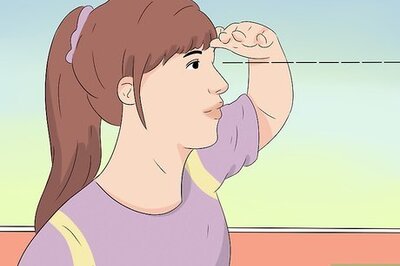
views
What are the benefits of a high-protein diet?
Proteins represent building blocks in your body. These building blocks help build muscle and can play a role in everything from blood clotting to the way your immune system fuctions. There are 9 amino acids found in proteins your body can’t produce by itself. These essential amino acids are responsible for protein synthesis, the absorption of nutrients, and the repair of tissues. A high-protein diet affects how much your body absorbs amino acids. EXPERT TIP Jeff Siegel Jeff Siegel Holistic Life Coach Jeff Siegel is a Holistic Life Coach and the Founder of Jeff Siegel Wellness. With nearly 10 years of experience, he specializes in mind-body medicine, life coaching, health and wellness coaching, mindfulness, corporate training, and transformational public speaking. He received a Master of Education from Harvard Graduate School of Education, a Master of Buddhist Studies from The University of Hong Kong, and a BSc in Neuroscience & Biology from Emory University. He’s also a certified personal trainer, a certified Eating Psychology Coach, and a certified Koru Mindfulness Teacher. Jeff Siegel Jeff Siegel Holistic Life Coach When you eat a protein, your body breaks that protein down into its component amino acids. Just paying attention to the types of proteins in [foods] and how digestible they are, [along with] how your body can extract them, is important.
When you increase protein intake for weight loss, you also target belly fat. A high-protein diet releases the peptide YY hormone, which causes you to feel full. It helps increase the speed of your metabolism and assists in maintaining muscle while you lose weight. By moderating alcohol consumption, eating plenty of soluble fiber, and lifting weights, you’ll also help reduce belly fat. These steps can decrease the probability of chronic conditions like type-2 diabetes and heart disease.
What amount of protein should you eat to lose weight?
A daily intake of .08 grams of protein may not be a high-enough level to lose weight. It’s a good idea to work with a registered dietician to find a healthy amount of protein that meets your body’s needs and encourages healthy weight loss. Factors like age, sex, and health conditions play a part in necessary protein levels. Older adults often require more protein, while women need less than men. A high-protein diet isn’t suitable for those with chronic kidney or heart disease, who require a much lower amount of protein. You can determine your necessary daily protein level using this formula.
Top 18 High-Protein Foods
Enjoy protein-packed meals with lean meats and fish. Focus on including chicken, turkey, salmon, and tuna for healthy dishes from morning to night. A 3-oz serving of chicken breast contains 27 grams of protein, while the same amount of salmon has 19 grams. Fill a whole-wheat wrap with lean turkey slices, hummus, and a tomato cucumber salad for a lunch that satisfies. Choose an Italian-style tuna salad that exchanges olive oil for mayonnaise. Mix in tomatoes, greens, white beans, and lemon juice for a flavorful meal that’s easy to prepare.
Vegetarian protein-rich foods include eggs, nuts, seeds, dairy, beans, and many vegetables. Each egg has 6 grams of protein, while half a cup of low-fat cottage cheese contains 12 grams. Legumes like lentils are also the perfect go-to at 18 grams of protein per cup. Combine lentils with sweet potatoes for a one-pot bake or make a pot of comforting lentil soup for a comforting weeknight meal.
Try adding tofu, soy, quinoa, and tempeh to protein-ready meals for something different. While firm tofu contains 22 grams of protein per serving. Though considered a grain, quinoa is very versatile in both warm dishes and salads. It has an impressive 8.14 grams of protein in each cup, along with many essential amino acids. Replace white rice with quinoa for a higher protein variation on traditional beans and rice. You can also feel fully satiated with a summery quinoa salad with tomatoes, red onion, black beans, and a vinaigrette dressing.
Drink your protein for an added boost. When you need a quick meal replacement or need a satisfying snack, enjoy a smoothie with added protein. Smoothies and shakes shouldn’t be your only source of protein, especially because too much can lead to bloating, nausea, or other digestion issues. Even if you use protein powder as a base for your smoothie, other great add-ons include Greek yogurt, chia or flax seeds, nut butter, low-fat or non-dairy milk, oats, and even tofu.
Add more protein to every meal
Use high-protein toppings for an added punch of protein. It’s a simple way to include protein in each meal and/or snack. EXPERT TIP Tara Coleman Tara Coleman Clinical Nutritionist Tara Coleman is a Clinical Nutritionist who has a private practice in San Diego, California. With over 15 years of experience, Tara specializes in sports nutrition, body confidence, and immune system health and offers personalized nutrition, corporate wellness, and online learning courses. She received a BS in Biology from James Madison University and spent six years in the pharmaceutical industry as an analytical chemist before founding her practice. Tara has been featured on NBC, CBS, Fox, ESPN, and Dr. Oz The Good Life as well as in Forbes, Cosmopolitan, Self, and Runner’s World. Tara Coleman Tara Coleman Clinical Nutritionist Make sure that every single time you eat, you're still getting protein in there. Instead of just an apple, have [an] apple and some nuts. Instead of oatmeal, add some hemp seeds or peanut butter to it, instead of just pasta, you can do a lentil-based pasta that has a little bit more protein to it. It’s as simple as sprinkling nuts, seeds, or nutritional yeast over your meal. Top your salad, rice, or avocado toast with an egg for additional protein. Build on delicious flavors with a spoonful or two of low-fat cheese for a creamy bonus to soups, salads, or pasta dishes. In addition to adding protein, you can replace ingredients with protein-rich variations. Swap out your spaghetti with lentil-based pasta for a dish full of flavor and plenty of protein to get you through the day. Use Greek yogurt instead of sour cream in soups and chilis to add protein and reduce fat without compromising on flavor.




















Comments
0 comment